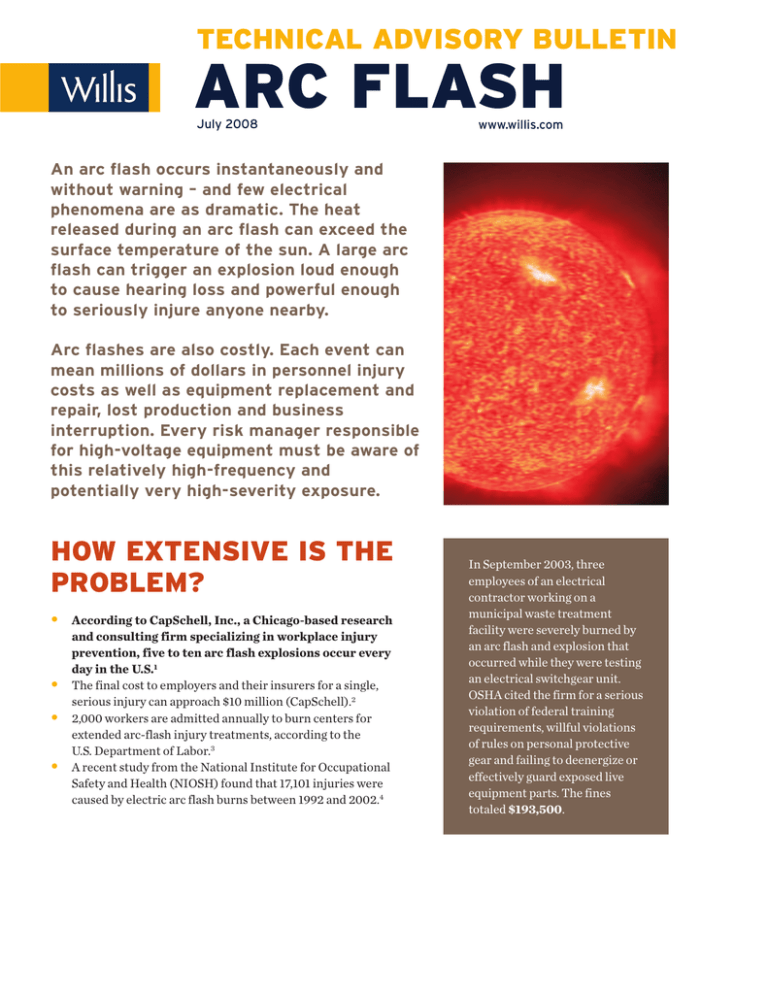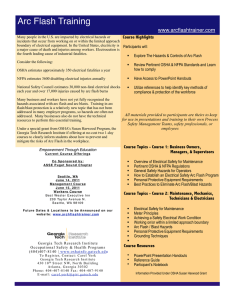Arc Flash
advertisement

TECHNICAL ADVISORY BULLETIN ARC FLASH July 2008 www.willis.com An arc flash occurs instantaneously and without warning – and few electrical phenomena are as dramatic. The heat released during an arc flash can exceed the surface temperature of the sun. A large arc flash can trigger an explosion loud enough to cause hearing loss and powerful enough to seriously injure anyone nearby. Arc flashes are also costly. Each event can mean millions of dollars in personnel injury costs as well as equipment replacement and repair, lost production and business interruption. Every risk manager responsible for high-voltage equipment must be aware of this relatively high-frequency and potentially very high-severity exposure. HOW EXTENSIVE IS THE PROBLEM? • According to CapSchell, Inc., a Chicago-based research • • • and consulting firm specializing in workplace injury prevention, five to ten arc flash explosions occur every day in the U.S.1 The final cost to employers and their insurers for a single, serious injury can approach $10 million (CapSchell).2 2,000 workers are admitted annually to burn centers for extended arc-flash injury treatments, according to the U.S. Department of Labor.3 A recent study from the National Institute for Occupational Safety and Health (NIOSH) found that 17,101 injuries were caused by electric arc flash burns between 1992 and 2002.4 In September 2003, three employees of an electrical contractor working on a municipal waste treatment facility were severely burned by an arc flash and explosion that occurred while they were testing an electrical switchgear unit. OSHA cited the firm for a serious violation of federal training requirements, willful violations of rules on personal protective gear and failing to deenergize or effectively guard exposed live equipment parts. The fines totaled $193,500. WHAT IS AN ARC FLASH? An arc flash occurs when an electric current passes through the air between ungrounded conductors, or between ungrounded conductors and grounded conductors. Resulting temperatures can reach 35,000°F. The intense heat of the arc causes the explosive expansion of both the surrounding air and the metal in the arc path. For example, copper expands by a factor of 67,000 when it turns from a solid to a vapor. The pressure generated can easily exceed hundreds or even thousands of pounds per square foot, a force equivalent to that of a hand grenade. Arc flashes are the result of arcing faults, which can occur through human error, especially during voltage testing and system shutdown and start-up. Arcing faults can also result from damaged insulation, accidental contact with energized components, equipment with incorrect short-circuit ratings, and corrosion and impurities that provide a current path. The conditions that create arcing faults within enclosed cabinets can be detected before flashover or arc flash incidents occur (usually when a cabinet is opened). These conditions are arcing, tracking and corona. • Arcing is a luminous discharge of current that is formed when a strong current jumps a gap in a circuit or between two electrodes. • Tracking is an electrical breakdown on the surface of an insulating material. A large • voltage difference gradually creates a conductive leakage path across the surface of the material by forming a carbonized track. A corona is a process by which a current, perhaps sustained, develops from an electrode with a high potential in a neutral medium, usually air, by ionizing that medium and creating a plasma around the electrode. The ions generated eventually pass charge to nearby areas of lower potential. Air near the electrode can become ionized (partially conductive), while more distant regions do not. When the air near the elctrode becomes conductive, it has the effect of increasing the apparent size of the conductor. Arcing, tracking, and corona emissions all produce ionization. Ionization is a process by which a neutral atom or molecule loses or gains an electron(s), thereby acquiring a net charge and becoming an ion. Ionization has by-products: ozone and nitrogen oxides. These combine with moisture to produce nitric acid, which is destructive to most dielectrics and certain metallic compositions, resulting in corrosion. ELECTRICAL CONDITION MONITORING An integrated detection approach incorporating infrared and ultrasound can uncover these conditions before an arcing event occurs. Ultrasound technology is ideally suited for detecting these emissions since the ionization process produces frequencies in the ultrasonic range. Arcing, tracking, corona, mechanical looseness and partial discharge all have distinct sound qualities that can be detected from the turbulence produced by the ionization of air. Partial discharges (PD) usually begin within voids, cracks or inclusions within a solid dielectric, at conductor-dielectic interfaces within solid or liquid dielectrics, or in bubbles within liquid dielectrics. Since discharges are limited to only a portion of the insulation, the 2 Willis North America • 07/08 discharges only partially bridge the distance between electrodes. PD can also occur along the boundary between different insulating materials. Partial discharges within an insulating material are usually initiated within gas-filled voids in the dielectric. Because the dielectric constant of the void is considerably less than the surrounding dielectric, the electric field (and the voltage stress) appearing across the void is significantly higher than across an equivalent distance of dielectric. If the voltage stress across the void is increased above the corona inception voltage (CIV) for the gas within the void, then PD activity will start within the void. Once begun, PD causes progressive deterioration of insulating materials, ultimately leading to electrical breakdown. PD can be prevented through careful design and material selection. In critical high-voltage equipment, the integrity of the insulation is confirmed using PD detection equipment during the manufacturing stage as well as periodically through the equipment's useful life. PD prevention and detection are essential to ensure reliable, long-term operation of high-voltage equipment. Heat is produced by the flow of current through corrosion or resistance and can be detected as a thermographic anomaly. Many insurers recommend an annual thermographic examination of all electrical equipment. Thorough resistance testing of all fuse holders and circuit breakers and primary current injection testing of all circuit breakers on a three-year cycle and power factor testing are also frequently recommended to determine insulation integrity. Fuse holders and circuit breakers are the most common equipment to suffer arc flash failures. Specialized training in these hazards and in ascertaining if workers are following appropriate work practices is available from various companies. Formal training sessions provide a basic understanding of what management can do to control this increasing problem and meet their legal and moral obligations to workers. STANDARDS AND CODES TO FOLLOW The OSHA General Industry Standard contains numerous references to electrical safety, most notably in Subpart S – Electrical, 1910.301 through 1910.399. These regulations are broken down as: • Safety Related Work Practices: Sections 331 through 360 • Safety Related Maintenance Requirements: Sections 361 through 380 • Safety Requirements for Special Equipment: Sections 381 through 399 The provisions of 1910.331 through 1910.335 cover electrical safety work practices for both qualified persons (those who have training in avoiding the electrical hazards of working on or near exposed energized parts) and 3 Willis North America • 07/08 unqualified persons (those with little or no such training). It should also be noted that 1910.147 requires the control of hazardous energy through a lockout or tagout program. OSHA requires powered equipment to be deenergized whenever possible before servicing or maintenance. The National Fire Protection Association (NFPA) is the primary source of the National Electrical Code Arc Flash Safety documentation and procedures. The National Electrical Code (NFPA 70-1987) is an ANSI standard which is recognized throughout the world. It has been adopted in whole or in part by most states or other legal jurisdictions of the U.S. as the guide for the safe installation of electrical conductors and equipment. It is generally accepted as the standard for electrical installations unless otherwise indicated. (The Canadian Standards Association's upcoming CSA Z462 Arc Flash Standard is under development and will become Canada's version of NFPA70E when it is released in 2008.) Given the hazards associated with energized electrical installations, the NFPA published NFPA 70E, Standard for Electrical Safety in the Workplace. In addition to the areas addressed in the OSHA standard, NFPA 70E also includes Installation Safety Requirements. This consensus standard also defines several recommended safety steps. • • • • • • • • • • Inspect/evaluate electrical equipment Maintain the equipment's insulation and enclosure integrity Plan every job and document first-time procedures Deenergize, if possible Anticipate unexpected events Identify and minimize the hazard Protect employees from shock, burn, blast and other hazards Use the right tools for the job Assess people's abilities Audit these procedures NFPA 70E also recommends that appropriate safety-related work practices be determined before any person approaches exposed live parts within the limited approach boundary, which refers to the distance that should be kept from an exposed live part. This boundary is determined by using both shock hazard analysis and flash hazard analysis. • Shock hazard analysis determines the voltage to which personnel • will be exposed, boundary requirements, and the personal protective equipment necessary in order to minimize the possibility of electrical shock. Flash hazard analysis determines the flash protection boundary and the personal protective equipment to protect personnel from the possibility of being injured by an arc flash. While OSHA does not enforce the requirements of NFPA 70E, the elements of this consensus standard provide employers with sound guidance in protecting their employees from electrical hazards in the workplace. Industry consensus standards, such as NFPA 70E, can be used by OSHA and employers as guides in the analysis of hazards and in the selection of hazard control measures. 4 Willis North America • 07/08 SAFETY FIRST Working safely with electrical installations requires knowledge and action. Voltage, wattage and other ratings of all electrical equipment must be marked, and disconnecting means and circuits must be identified and distinguished. Employees must be provided with all necessary personal protective equipment including, if necessary, fire protective clothing. Adherence to the OSHA regulations and utilizing consensus standards, such as NFPA 70E, should be a requirement of any risk management program. For those seeking further information on the subject or arc flash safety and arc flash risk control methods, the following sources of information are recommended. • FM Data Sheets, particularly Data Sheets 5-7, include recommended testing and frequencies, FM Global • NFPA 70E Standard for Electrical Safety in the Workplace • NIOSH DVD “Arc Flash Awareness,” ESFI.org • “Methods of Inspection to Determine the Presence of Potential Arc Flash Incidents,” NETAWORLD.ORG • “Arc Flash Protection should be job No. 1,” PowerMag.com, February 2007 • “Arc Flash,” Wikipedia.org 1 2 3 4 “Protect Your Employees From Arc Flash,” CapSchell, http://www.esfi.org/documents/ArcFlashNRFeature_2.pdf. Ibid. NIOSH Publication No. 98-131: Worker Deaths by Electrocution, http://www.cdc.gov/niosh/docs/98-131. “Arc Flash Protection Should be Job No. 1,” IEEE/NFPA Collaboration on Arc Flash Phenomena, in http://www.powermag.com, Feb. 2007. CONTACT For more information please contact: Earl D. Owen, CPCU, ARM Senior Vice President & Senior Resource Consultant Willis Risk Solutions Large Property Practice +1 617 351 7532 earl.owen@willis.com Stephen B. Larkin Vice President Risk Control Services +1 516 941 0263 stephen.larkin@willis.com 5 Willis North America • 07/08


